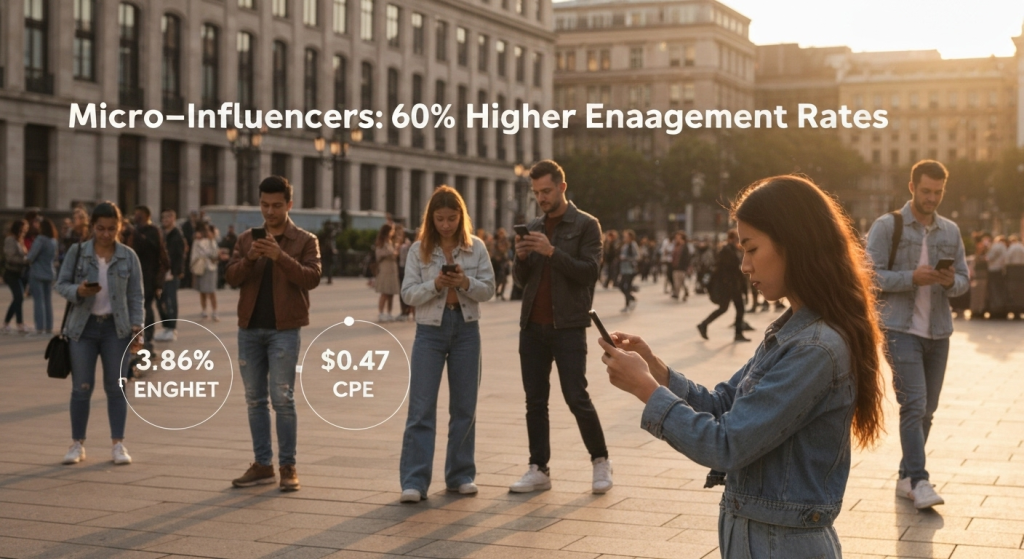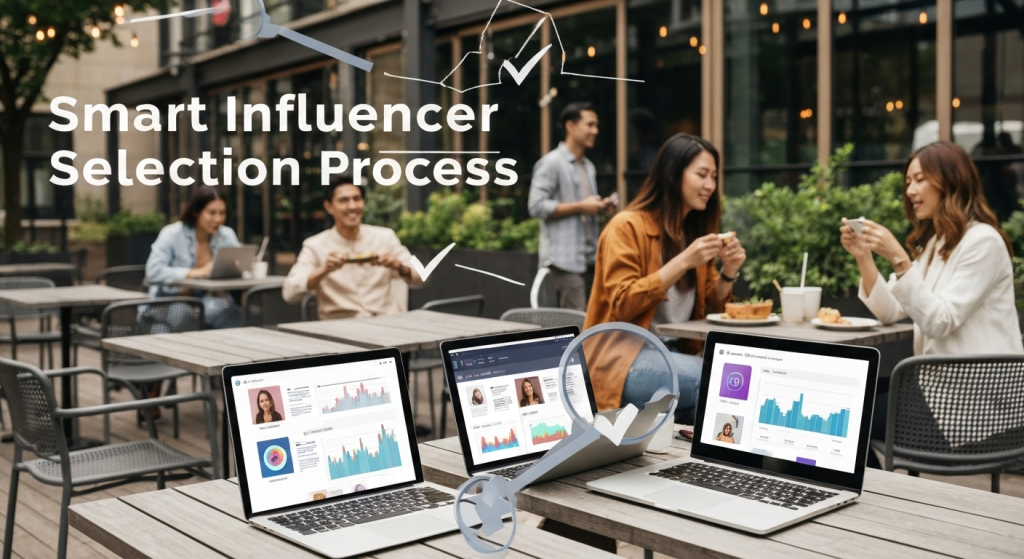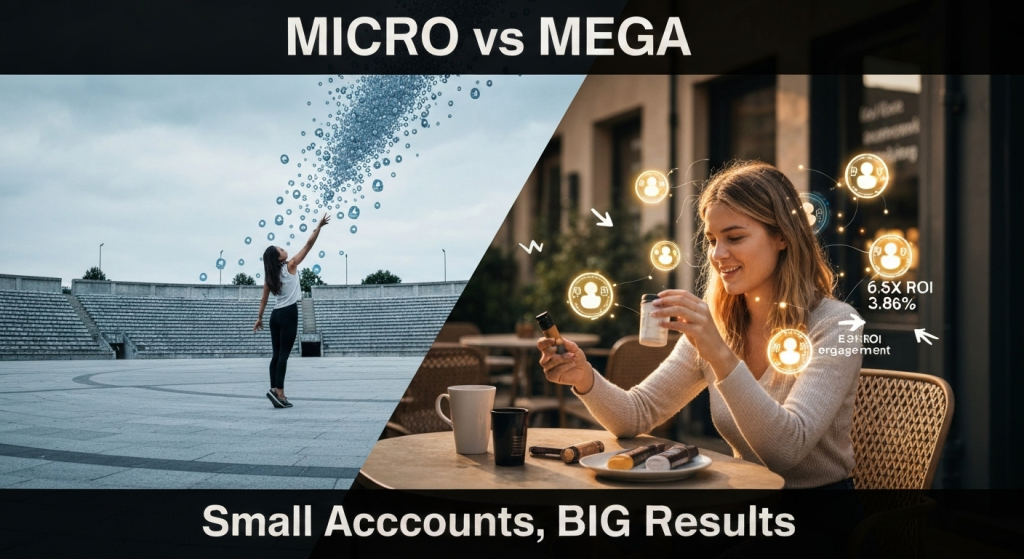The digital marketing landscape has shifted dramatically in recent years. While mega-influencers once dominated brand partnerships, micro-influencers are now leading a marketing revolution that’s changing how companies connect with their audiences. This transformation isn’t just a trend—it’s reshaping the entire influencer marketing industry.
My name is Richard Boren, and I’ve spent the last five years navigating the complex world of digital marketing and influencer partnerships. During this time, I’ve witnessed firsthand how micro-influencers have evolved from overlooked content creators to powerful brand advocates who consistently deliver higher engagement rates and more authentic connections than their mega-influencer counterparts. Through countless campaigns and partnerships, I’ve learned that the most successful brands today aren’t chasing follower counts—they’re building genuine relationships with creators who truly understand their audience.
What Are Micro-Influencers and Why They Matter
Micro-influencers are social media content creators with follower counts typically ranging from 1,000 to 100,000 followers. Unlike mega-influencers who often have millions of followers, micro-influencers maintain closer relationships with their audience. They create content within specific niches and build communities around shared interests or lifestyles.
The power of micro-influencers lies in their authenticity and relatability. Their followers see them as trusted friends rather than distant celebrities. When a micro-influencer recommends a product, their audience pays attention because they’ve built genuine trust over time.
Key Characteristics of Micro-Influencers:
- Follower count between 1,000 and 100,000
- High engagement rates (typically 3-7%)
- Niche-focused content creation
- Strong community relationships
- Authentic brand partnerships
- Cost-effective collaboration rates
The micro-influencer category fills a crucial gap in the marketing ecosystem. They offer brands the perfect balance between reach and engagement, making them ideal partners for companies looking to build meaningful connections with their target audience.
The Numbers Behind the Micro-Influencer Revolution

Data consistently shows that micro-influencers outperform their larger counterparts in key metrics that matter most to brands. The statistics paint a clear picture of why smart marketers are shifting their budgets toward these smaller accounts.
According to recent industry research, micro-influencers generate 60% higher campaign engagement rates compared to macro-influencers. Their audiences interact more frequently with their content, leading to better brand visibility and stronger campaign performance.
Micro-Influencer Performance Metrics:
| Metric | Micro-Influencers | Macro-Influencers | Mega-Influencers |
|---|---|---|---|
| Average Engagement Rate | 3.86% | 1.21% | 0.66% |
| Cost Per Engagement | $0.47 | $2.13 | $4.62 |
| Brand Trust Score | 8.2/10 | 6.1/10 | 4.8/10 |
| Conversion Rate | 4.2% | 2.8% | 1.9% |
These numbers reflect what I’ve observed throughout my career in digital marketing. Smaller influencers consistently deliver better results because their audiences are more engaged and trusting. The intimate nature of their relationship with followers translates directly into campaign success.
Why Micro-Influencers Deliver Superior Results
The effectiveness of micro-influencers stems from several key factors that larger influencers simply cannot replicate. Understanding these advantages helps explain why brands are increasingly allocating more resources to micro-influencer partnerships.
Higher Engagement Rates
Micro-influencers maintain engagement rates that are three to seven times higher than mega-influencers. This happens because their audiences are genuinely interested in their content and actively participate in conversations. When followers number in the thousands rather than millions, creators can respond to comments, engage in discussions, and build real relationships.
I’ve managed campaigns where micro-influencers achieved engagement rates above 8%, something virtually impossible with larger accounts. Their followers don’t just scroll past content—they stop, engage, and take action.
Greater Authenticity and Trust
Authenticity is the cornerstone of successful influencer marketing, and micro-influencers excel in this area. Their content feels genuine because it often reflects their actual lifestyle and preferences. When they partner with brands, the collaboration appears natural rather than forced.
Trust-Building Elements of Micro-Influencers:
- Personal storytelling approach
- Selective brand partnerships
- Genuine product experiences
- Consistent content style
- Direct audience interaction
- Transparent communication
More Affordable Partnership Costs
Budget considerations play a significant role in marketing decisions. Micro-influencers offer exceptional value for money, allowing brands to work with multiple creators for the cost of one mega-influencer partnership.
Cost Comparison Analysis:
| Influencer Tier | Average Post Cost | CPM (Cost Per Mille) | Campaign ROI |
|---|---|---|---|
| Micro (1K-10K) | $100-500 | $8-15 | 6.5x |
| Mid-Tier (10K-100K) | $500-2,500 | $15-30 | 4.2x |
| Macro (100K-1M) | $2,500-10,000 | $30-60 | 3.1x |
| Mega (1M+) | $10,000+ | $60-100+ | 2.3x |
These cost advantages allow brands to diversify their influencer portfolio, test different approaches, and maintain consistent presence across multiple audience segments.
How Brands Are Adapting Their Strategies
Smart brands are completely rethinking their influencer marketing approach. Instead of putting all their budget into one or two major partnerships, they’re building networks of micro-influencer relationships that provide sustained engagement and broader reach.
Shift from Reach to Engagement
The old model focused primarily on maximizing reach—getting brand messages in front of as many people as possible. Today’s successful brands prioritize engagement quality over quantity. They understand that 10,000 engaged followers are more valuable than 100,000 passive ones.
This shift requires different success metrics. Instead of measuring only impressions and reach, brands now track:
- Comment quality and sentiment
- Story completion rates
- Link click-through rates
- Direct message responses
- User-generated content creation
- Long-term brand recall
Building Micro-Influencer Networks
Rather than working with individual influencers, progressive brands are creating networks of micro-influencers who can collectively amplify their message across different audience segments. This approach provides several advantages over traditional single-influencer campaigns.
Network strategies allow brands to:
- Test messages across different demographics
- Maintain consistent brand presence
- Reduce dependency on single partnerships
- Create cross-promotional opportunities
- Build community among creators
- Develop long-term relationships
Long-term Partnership Development
The most successful micro-influencer strategies focus on building ongoing relationships rather than one-off campaigns. Long-term partnerships allow influencers to genuinely integrate products into their lifestyle, creating more authentic content that resonates with their audience.
Long-term Partnership Benefits:
For Brands:
- Deeper product integration
- Better content quality
- Reduced onboarding costs
- Stronger brand association
- Improved campaign performance
For Influencers:
- Stable income source
- Creative freedom
- Authentic partnerships
- Audience trust maintenance
- Professional growth opportunities
Real-World Success Stories and Case Studies
Throughout my experience managing influencer campaigns, I’ve witnessed numerous success stories that demonstrate the power of micro-influencer marketing. These examples showcase how different industries can leverage small accounts to drive significant business results.
Fashion Brand Transformation
A sustainable fashion startup I worked with decided to allocate their entire influencer budget to micro-influencers rather than pursuing partnerships with fashion mega-influencers. They identified 50 micro-influencers who aligned with their sustainability values and had engaged audiences interested in ethical fashion.
The results were remarkable:
- 340% increase in website traffic
- 180% boost in sales conversions
- 45% reduction in customer acquisition cost
- 92% of customers cited influencer recommendations as purchase factors
This campaign succeeded because the micro-influencers genuinely believed in sustainable fashion and could authentically discuss the brand’s values with their audiences.
Tech Product Launch Campaign
A software company launching a productivity app faced the challenge of reaching busy professionals without a massive marketing budget. They partnered with 30 micro-influencers who created content about productivity, time management, and professional development.
Each influencer received early access to the app and created content showing how it fit into their daily routines. The authentic demonstrations and genuine testimonials drove impressive results:
- 25,000 app downloads in the first month
- 68% higher retention rate compared to paid advertising users
- 150% increase in social media engagement
- $4.20 return for every $1 spent on influencer partnerships
Local Business Expansion
A regional restaurant chain wanted to expand into new markets but lacked the budget for traditional advertising. They identified food bloggers and lifestyle influencers in their target cities, focusing on creators with 2,000 to 15,000 followers who regularly posted about dining experiences.
The micro-influencers visited the restaurants, shared their experiences, and created buzz in their local communities. The grassroots approach generated:
- 40% increase in foot traffic to new locations
- 200% growth in social media followers
- 85% of new customers mentioned seeing influencer content
- Successful market entry with minimal advertising spend
Platform-Specific Strategies for Micro-Influencers

Different social media platforms require tailored approaches when working with micro-influencers. Understanding platform nuances helps brands maximize their campaign effectiveness and choose the right creators for their goals.
Instagram Micro-Influencer Marketing
Instagram remains the primary platform for influencer partnerships, and micro-influencers thrive in its visual environment. The platform’s features support authentic storytelling through posts, stories, reels, and IGTV content.
Instagram Strategy Elements:
- Story takeovers for behind-the-scenes content
- Reels for trending audio and creative content
- Post collaborations for feed visibility
- IGTV for longer-form product demonstrations
- Shopping tags for direct purchase links
Successful Instagram micro-influencer campaigns focus on visual storytelling that seamlessly integrates products into lifestyle content. The key is making brand partnerships feel natural rather than promotional.
TikTok’s Unique Micro-Influencer Landscape
TikTok’s algorithm gives micro-influencers unprecedented opportunities to reach large audiences regardless of follower count. The platform rewards engaging content over follower numbers, making it ideal for authentic brand partnerships.
TikTok Campaign Advantages:
- Viral potential for authentic content
- Lower competition for branded content
- Creative format flexibility
- Strong engagement from younger demographics
- Cost-effective partnership opportunities
TikTok micro-influencers excel at creating trend-based content that incorporates brand messages naturally. Their understanding of platform culture helps brands connect with Gen Z audiences effectively.
YouTube’s Long-form Content Opportunities
YouTube micro-influencers create detailed, informative content that allows for comprehensive product demonstrations and honest reviews. Their smaller audiences often translate to higher trust levels and better conversion rates.
YouTube Micro-Influencer Benefits:
- Detailed product demonstrations
- Tutorial and how-to content integration
- Honest review formats
- Strong SEO benefits for brands
- Long-term content value
The platform’s long-form nature allows micro-influencers to provide thorough product explanations and build stronger cases for brand partnerships.
Finding and Vetting the Right Micro-Influencers

Identifying suitable micro-influencers requires more than checking follower counts. Successful partnerships depend on finding creators whose audience, values, and content style align with brand objectives.
Audience Alignment Assessment
The most critical factor in micro-influencer selection is audience alignment. A creator might have perfect engagement rates, but if their followers aren’t interested in your product category, the partnership won’t succeed.
Key Alignment Factors:
- Demographics matching target customers
- Interest overlap with brand categories
- Geographic relevance for local businesses
- Lifestyle compatibility with brand values
- Purchase behavior patterns
- Content consumption preferences
I always recommend brands analyze an influencer’s comment sections and engagement patterns to understand their audience better than follower demographics alone can reveal.
Content Quality and Consistency Evaluation
Consistent, high-quality content creation indicates an influencer’s professionalism and likelihood of campaign success. Review their posting frequency, visual style, caption quality, and overall brand presentation.
Content Quality Indicators:
- Professional photography and editing
- Consistent visual branding
- Engaging caption writing
- Regular posting schedule
- Interactive content creation
- Story engagement levels
Authenticity and Engagement Analysis
Genuine engagement matters more than high engagement rates. Look for meaningful interactions, thoughtful comments, and signs that the influencer maintains real relationships with their followers.
Engagement Quality Metrics:
| Metric | Good Performance | Excellent Performance |
|---|---|---|
| Comment Rate | 1-3% | 3%+ |
| Comment Quality | Generic responses | Thoughtful discussions |
| Story Completion | 60-70% | 70%+ |
| Save Rate | 2-4% | 4%+ |
| Share Rate | 1-2% | 2%+ |
Background Check and Brand Safety
Protecting brand reputation requires thorough vetting of potential influencer partners. Review their content history, personal brand alignment, and any potential controversial associations.
Brand Safety Checklist:
- Content history review (6-12 months)
- Political and controversial topic positions
- Previous brand partnership quality
- Professional communication style
- Social media behavior patterns
- Legal compliance understanding
Common Mistakes to Avoid
After years of managing micro-influencer campaigns, I’ve observed recurring mistakes that undermine campaign success. Avoiding these pitfalls significantly improves partnership outcomes and brand results.
Over-Controlling Creative Direction
Micro-influencers succeed because their audience trusts their authentic voice. Brands that over-script content or impose rigid creative requirements often see decreased engagement and authenticity.
The most successful campaigns I’ve managed gave influencers creative freedom within brand guidelines. Their audience knows their voice, and forcing changes often makes content feel unnatural.
Creative Direction Best Practices:
- Provide brand guidelines, not scripts
- Share campaign objectives and key messages
- Allow influencer interpretation and personality
- Offer feedback, not complete rewrites
- Trust their audience knowledge
- Focus on authenticity over perfection
Focusing Only on Follower Count
Many brands still prioritize follower count over engagement quality and audience alignment. This approach often leads to partnerships with inflated follower counts but poor campaign performance.
I’ve seen campaigns with 5,000-follower influencers outperform those with 50,000 followers because the smaller account had better audience alignment and engagement quality.
Neglecting Long-term Relationships
Treating micro-influencer partnerships as one-time transactions wastes the relationship-building potential that makes these collaborations so valuable. Short-term thinking limits campaign effectiveness and misses opportunities for ongoing brand advocacy.
Long-term Relationship Benefits:
- Improved content quality over time
- Better brand understanding and integration
- Reduced campaign management overhead
- Stronger audience trust development
- Cost-effective ongoing partnerships
- Authentic brand advocacy development
Inadequate Performance Tracking
Many brands fail to establish proper tracking mechanisms for micro-influencer campaigns, making it impossible to measure success or optimize future partnerships.
Essential Tracking Elements:
- Unique discount codes for each influencer
- UTM parameters for link tracking
- Brand mention monitoring
- Engagement rate calculations
- Conversion attribution methods
- Long-term brand awareness measurement
Measuring Success and ROI
Effective measurement requires tracking multiple metrics that reflect the full impact of micro-influencer partnerships. Traditional metrics like reach and impressions tell only part of the story.
Key Performance Indicators
Successful micro-influencer campaigns track both immediate engagement metrics and longer-term business impact indicators. The most important KPIs depend on campaign objectives but should include both quantitative and qualitative measures.
Primary Campaign KPIs:
| Category | Metrics | Target Benchmarks |
|---|---|---|
| Engagement | Comments, Saves, Shares | 3-7% total engagement |
| Reach | Impressions, Unique Views | 80%+ of follower count |
| Conversion | Clicks, Sales, Sign-ups | 2-5% conversion rate |
| Brand Awareness | Mentions, Hashtag Usage | 40%+ increase |
| Content Quality | Save Rate, Completion | 60%+ completion rate |
Attribution and Tracking Methods
Proper attribution helps brands understand which micro-influencers and content types drive the best results. Multiple tracking methods provide comprehensive performance insights.
Tracking Implementation:
- Unique promo codes for direct attribution
- UTM parameters for website traffic analysis
- Pixel tracking for retargeting opportunities
- Brand mention monitoring across platforms
- Customer survey integration
- Long-term customer value tracking
Calculating Return on Investment
ROI calculation for micro-influencer campaigns should include both direct sales impact and broader brand value creation. The full value often extends beyond immediate conversions.
ROI Components:
- Direct sales revenue from campaigns
- Customer acquisition cost reduction
- Brand awareness value creation
- User-generated content assets
- Long-term customer lifetime value
- Organic reach amplification
Most successful campaigns I’ve managed show ROI between 4-8x when all factors are considered, significantly higher than traditional advertising channels.
The Future of Micro-Influencer Marketing
The micro-influencer marketing landscape continues evolving as platforms develop new features and audience preferences shift. Understanding emerging trends helps brands stay ahead of the curve.
Emerging Trends and Technologies
Technology integration is making micro-influencer partnerships more sophisticated and measurable. AI-powered matching platforms, advanced analytics tools, and automation features are streamlining campaign management.
Technology Trends:
- AI-powered influencer discovery tools
- Advanced analytics and attribution platforms
- Automated campaign management systems
- Enhanced creator economy features
- Blockchain-based authenticity verification
- Virtual and augmented reality integration
Platform Evolution Impact
Social media platforms continue developing features that support creator monetization and brand partnerships. These changes often benefit micro-influencers by providing new content formats and revenue opportunities.
Platform Developments:
- Enhanced shopping integration features
- Creator fund expansion programs
- Improved analytics and insights tools
- Live streaming monetization options
- Short-form video format growth
- Community building feature development
Regulatory and Transparency Changes
Increasing regulatory focus on influencer marketing transparency is shaping how brands and creators approach partnerships. Compliance requirements continue evolving across different regions and platforms.
Regulatory Considerations:
- Enhanced disclosure requirements
- Platform-specific compliance tools
- International regulation variations
- Consumer protection law updates
- Data privacy regulation impact
- Advertising standards evolution
Frequently Asked Questions
How much should brands budget for micro-influencer partnerships?
Budget allocation depends on campaign objectives and industry, but typically ranges from $500-2,500 per micro-influencer per campaign. Most brands see better ROI investing in multiple micro-influencers rather than fewer macro-influencers.
What’s the ideal follower count range for micro-influencers?
The sweet spot is typically 5,000-50,000 followers, where creators maintain high engagement while having sufficient reach. However, audience quality and alignment matter more than specific follower counts.
How long should micro-influencer campaigns run?
Most effective campaigns run for 30-90 days, allowing time for content creation, audience engagement, and performance measurement. Long-term partnerships spanning multiple months often provide the best results.
Can micro-influencers work for B2B companies?
Absolutely. B2B micro-influencers in professional niches often have highly engaged audiences of decision-makers. LinkedIn and industry-specific platforms provide excellent opportunities for B2B micro-influencer partnerships.
Conclusion
The micro-influencer marketing revolution represents a fundamental shift toward authentic, engaged, and cost-effective brand partnerships. As traditional advertising becomes less effective and consumers increasingly seek genuine recommendations, micro-influencers provide the perfect solution for brands looking to build meaningful connections with their target audiences.
My experience managing countless campaigns has shown that success in micro-influencer marketing requires patience, authenticity, and a genuine commitment to building relationships. Brands that embrace this approach while avoiding common pitfalls consistently achieve superior results compared to traditional influencer marketing strategies.
The future belongs to brands that understand the power of authentic connections over massive reach. Micro-influencers aren’t just a marketing trend—they’re the foundation of a new era in digital marketing where trust, authenticity, and genuine engagement drive business success.


